
Isaac and Jacob is an oil on canvas painting by Jusepe de Ribera, executed in 1637, which since 1918 has been in the Prado Museum in Madrid.

Isaac and Jacob is an oil on canvas painting by Jusepe de Ribera, executed in 1637, which since 1918 has been in the Prado Museum in Madrid.
Nothing is known about who commissioned the painting for the Royal Collections, but in 1734 the work was in the Royal Alcázar of Madrid, possibly in the Hall of Mirrors, from which it had to be moved due to a fire that occurred in that year. It then went to the Royal Palace where it remained until after the War of Independence, when it was taken to the San Fernando Academy to finally move to the Prado Museum in 1854. [1]
The painting represents what is described in Genesis (27, 1-29), when Jacob, helped by his mother Rebekah, deceives his blind father Isaac to receive the blessing meant for his older brother, Esau. To carry out the deception, Jacob covers one arm with a sheepskin, imitating the hairy arms of his brother.
In the work, which all critics consider one of Ribera's most mature, we see the half-length characters, with Isaac lying on the bed feeling his arm, Jacob sitting on the bed and the mother, with a Vélazquez inspired look, encouraging her child to cheat. On the left we also see Esau returning from hunting.
Ribera creates an almost theatrical scene where with his chromatic skill and the marvelous use of a vibrant light he manages to make us feel the environment, almost touch the objects and transmit the touch of the fabrics, of the sheepskin and give the faces of the characters an amazing naturalism. Remarkable is the still life to the right of the canvas which, although it was a genre that Ribera hardly practiced, was a sure point of reference for the work on this subject by later painters.
The point of view of the work, whose focal point is considerably low, and the elongated format of the painting, suggests that it was painted to be viewed from below, perhaps positioned as an over-door or over-window. [2] [3]

Baroque painting is the painting associated with the Baroque cultural movement. The movement is often identified with Absolutism, the Counter Reformation and Catholic Revival, but the existence of important Baroque art and architecture in non-absolutist and Protestant states throughout Western Europe underscores its widespread popularity.

The Museo del Prado, officially known as Museo Nacional del Prado, is the main Spanish national art museum, located in central Madrid. It houses collections of European art, dating from the 12th century to the early 20th century, based on the former Spanish royal collection, and the single best collection of Spanish art. Founded as a museum of paintings and sculpture in 1819, it also contains important collections of other types of works. The numerous works by Francisco Goya, the single most extensively represented artist, as well as by Hieronymus Bosch, El Greco, Peter Paul Rubens, Titian, and Diego Velázquez, are some of the highlights of the collection. Velázquez and his keen eye and sensibility were also responsible for bringing much of the museum's fine collection of Italian masters to Spain, now one of the largest outside of Italy.

Luis de Morales was a Spanish painter active during the Spanish Renaissance in the 16th century. Known as "El Divino", most of his work was of religious subjects, including many representations of the Madonna and Child and the Passion.

Jusepe de Ribera was a Spanish painter and printmaker. Ribera, Francisco de Zurbarán, Bartolomé Esteban Murillo, and the singular Diego Velázquez, are regarded as the major artists of Spanish Baroque painting. Referring to a series of Ribera exhibitions held in the late 20th century, Philippe de Montebello wrote "If Ribera's status as the undisputed protagonist of Neapolitan painting had ever been in doubt, it was no longer. Indeed, to many it seemed that Ribera emerged from these exhibitions as not simply the greatest Neapolitan artist of his age but one of the outstanding European masters of the seventeenth century." Jusepe de Ribera has also been referred to as José de Ribera, Josep de Ribera, and Lo Spagnoletto by his contemporaries, early historians, and biographers.

Jacob's Dream is a 1639 oil-on-canvas painting by the Spanish Tenebrist painter José de Ribera.

Bartolomeo Cavarozzi (1587–1625), occasionally referred to as Bartolomeo Crescenzi, was an Italian caravaggisti painter of the Baroque period. Cavarozzi's work began receiving increased admiration and appreciation from art historians in the last few decades of the 20th century, emerging as one of the more distinct and original followers of Caravaggio. He received training from Giovanni Battista Crescenzi in Rome and later traveled to Spain alongside his master for a few years where he achieved some renown and was significant in spreading "Caravaggism" to Spain before returning to Italy. His surviving works are predominantly Biblical subjects and still-life paintings, although older references note he "was esteemed a good painter especially of portraits".

The Pietà is a painting by José de Ribera, "The Españoleto", painted, signed and dated in 1633.

The Martyrdom of Saint Philip is a painting by Jusepe de Ribera from 1639.

Ixion is a 1632 oil painting, signed and dated by Jusepe de Ribera. It shows a scene from Classical mythology, of Ixion being tortured as the eternal punishment meted out by Zeus. It is one of a series of four paintings by Ribera of the four "Furies" or "Condemned" from Greek mythology. It is held by the Museo del Prado in Madrid, along with Ribera's painting of Tityos; the other two, of Sisyphus and Tantalus, are lost.
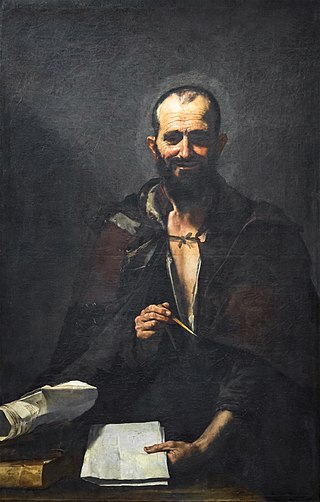
Democritus is an oil on canvas painting by Jusepe de Ribera, executed in 1630, now in the Museo del Prado, in Madrid. It is believed to depict the Ancient Greek philosopher Democritus.

The Martyrdom of Saint Andrew is a 1628 painting by Jusepe de Ribera. It depicts the martyrdom of Saint Andrew, one of the Twelve Apostles.

The Ford or Landscape with Shepherds is a 1644 oil-on-canvas painting by the French artist Claude Lorrain, now in the Prado Museum, in Madrid.

The Earthly Trinity with Saints and God the Father are a pair of c.1626-c.1635 oil on canvas paintings by Jusepe de Ribera, both now in the Museo nazionale di Capodimonte in Naples. Along with the Holy Family, the main work shows Bruno of Cologne, Benedict of Nursia, Bernardino of Siena and Bonaventure.
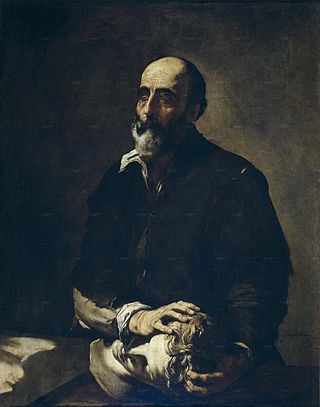
The Blind Sculptor is an oil on canvas painting by José de Ribera, signed and dated to 1632. Its origins are unknown - the first documentary reference to the work is a 1764 inventory of the collections at El Escorial, from which it moved to its present home at the Prado Museum in 1837.
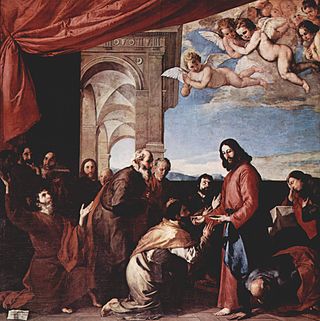
The Last Supper or The Communion of the Apostles is a 1651 oil on canvas painting by Jusepe de Ribera, still in the choir of the Certosa di San Martino in Naples, for which it was commissioned.
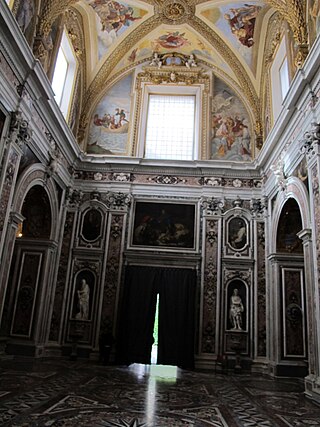
Prophets and Patriarchs is a series of fourteen oil on canvas paintings produced between 1638 and 1643 by Jusepe de Ribera along the nave walls of the church of the Certosa di San Martino in Naples, where they still hang. Moses and Elijah hang behind the west facade, whilst the rest hang under the arches of the side chapels.
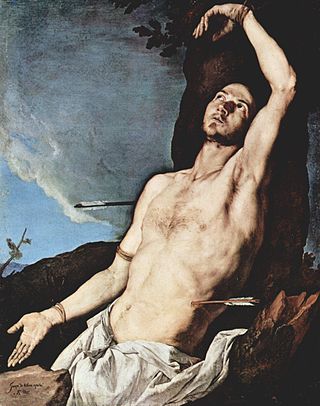
Saint Sebastian is a 1651 oil on canvas painting by Jusepe de Ribera. With Saint Bruno Receiving the Rule and Saint Jerome, it is one of three works commissioned from him for the private quarters of the prior of the Certosa di San Martino in Naples, where they still hang. A work of his second maturity, it is a second version of a 1636 work now in Madrid.

Saint Sebastian was a 1636 oil on canvas painting by Jusepe de Ribera, lost after or more probably in the fire at the Flakturm Friedrichshain in May 1945 or the ensuing looting by Soviet troops.

The Flagellation of Christ is a c.1618 oil on canvas painting by Jusepe de Ribera, from the start of his stay in Naples. A smaller autograph copy without the accompanying figure on the right is now in the Galleria Sabauda in Turin.